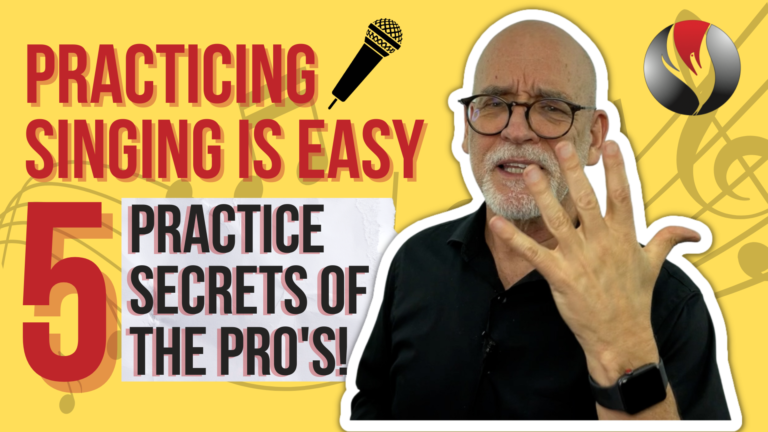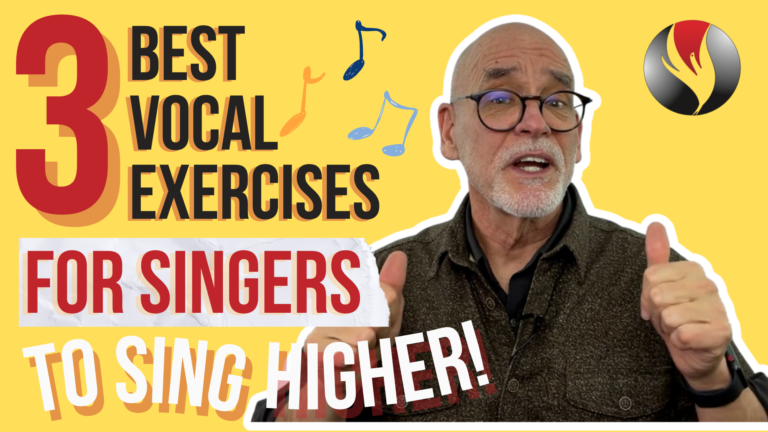Ep.24: How to sing high notes? Modify the Vowel
A leading cause of straining, breaking and flipping when you sing high notes is the vowel you’re singing. You need to modify the vowel as you sing higher.
This may be one of the most effective and powerful ways to succeed when you want to sing high notes. Inside this video, I’ll show you how to modify the vowel to successfully sing high notes in your songs.
Hi, I’m Chuck Gilmore with Power To Sing.
How do you modify a vowel and how can it help you be impressive when you sing high notes?
As the pitch goes up, laws of acoustics require that the vowel be modified. Some refer to modifying a vowel as “rounding”, “darkening”, “narrowing” or “closing”.
There’s also a negative modifying of vowels that causes many singers problems. This kind of modifying is called “spreading”, “opening” or “widening” the vowel. This is the opposite of the positive “rounding” of the vowel.
Vowel spreading causes many problems when you try to sing high notes.
I’ll demonstrate vowel spreading and vowel narrowing using the vowel “o”, pronounced in American English as “No” or “Oh”.
First vowel spreading. This is modifying the vowel by letting it spread wide. This causes bad things to happen in the voice. The vibration or resonance on the lower pitches occurs in the chest. As the pitch moves upward, the resonance in our chest also moves upward eventually moving into our head cavities.
If the vowel “o” spreads or “opens” wider from “oh” and more toward “ouh” as in “good” or even wider as in “uh” (mud) or “a” (father) then two things happen.
- The natural resonance shift into the head cavity is difficult or impossible
- The vocal cords do not thin or adjust enough. This causes strain, reach, breaks, cracks, flips and poor pitch and tone…often called a “splat” or spatty tone.

Listen as I demonstrate. I’ll use the “o” on a simple scale that takes me to my highest notes. [Vocal Demo]
How to Sing High Notes
Second, vowel rounding or narrowing. This is modifying the vowel by slightly closing the “oh” by gradually introducing “u” (new) into the “oh” as the pitch goes up.
If the vowel narrows with two things happen.
- The natural resonance shift from chest to head in made easier and often effortless
- The vocal cords also thin and adjust enough to eliminate the mass of the vocal cords, which removes the strain and reach.
Listen as I demonstrate. [Vocal Demo] You hear the “u” introduced into the “o” as I went higher. This allowed me to pass through the bridge into my head voice with very little effort.

This slight modifying of “oh” keeps it sounding like “oh” instead of spreading wider into “ouh” or “a” and makes our words sound natural and understandable.
The best way to do this as you sing the high notes is to think of a word with a more narrow or closed vowel.
How to Sing High Notes in the Star Spangled Banner
For example, if you’re singing the US national anthem at the World Series or the Superbowl, the vowels in the words “rockets red glare” can be thought of as “ruckets rid glib”.
Let me show you. I’ll sing it wide. [Vocal Demo] If I think of the words “ruckets rid glib” and insert that vowel sound into that phrase, listen what happens. [Vocal Demo]
Slightly narrowing the vowel as you sing high notes makes a huge difference in your singing.
If you routinely do not do this, you are likely pulling chest voice. This means your vocal type is likely Pulled Chest/High Larynx. Often times this is also characteristic of the Flip-Falsetto Vocal Type.
Do you know your vocal type? I’m not referring to whether you are soprano, alto, tenor or bass. Your vocal type describes what you tend to do when you sing.
Visit PowerToSing.com and take the vocal test, which I call the PowerTest. Take the quiz and immediately discover your vocal type.
Visit the Knowledge Center and learn about your vocal type and then download the free vocal exercises. These exercises are designed for your vocal type and will help you make real progress with your voice.
I’m Chuck Gilmore with Power To Sing.
You can sing higher with beauty, confidence and power.
I’ll see you inside the next video.








Responses